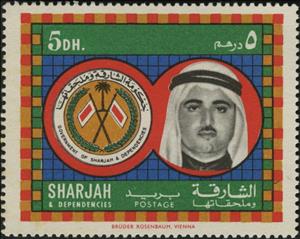Stamp: Sheikh Khalid, Coat of Arms (Sharjah 1968)
Sheikh Khalid, Coat of Arms (Sharjah 1968)
25 May (Sharjah ) within release Sheikh Khalid bin Mohammed al Qasimi goes into circulation Stamp Sheikh Khalid, Coat of Arms face value 5 Qatari dirham
| Stamp Sheikh Khalid, Coat of Arms in catalogues | |
|---|---|
| Michel: | Mi: AE-SH 434 |
| Stamp Number: | Sn: AE-SH 361 |
| Yvert et Tellier: | Yt: AE-SH 211 |
| Stanley Gibbons: | Sg: AE-SH 255 |
| Colnect codes: | Col: AE-SH 1968.05.25-01 |
Stamp is square format.
Yvert et Tellier footnotes an imperforate variant, not confirmed by other catalogsAlso in the issue Sheikh Khalid bin Mohammed al Qasimi:
- Stamp - Sheikh Khalid Bin Mohammed Al Qasimi face value 15;
- Stamp - Sheikh Khalid Bin Mohammed Al Qasimi face value 60;
- Stamp - Sheikh Khalid Bin Mohammed Al Qasimi face value 3;
- Stamp - Sheikh Khalid, Coat of Arms face value 5;
- Stamp - Sheikh Khalid, Coat of Arms face value 35;
- Stamp - Sheikh Khalid, Coat of Arms face value 1;
- Stamp - Sheikh Khalid, Flag face value 10;
- Stamp - Sheikh Khalid, Flag face value 40;
- Stamp - Sheikh Khalid, Flag face value 2;
- Stamp - Sheikh Khalid, Flag face value 10;
- Stamp - Sheikh Khalid, Flag and Coat of Arms face value 20;
- Stamp - Sheikh Khalid, Flag and Coat of Arms face value 75;
- Stamp - Sheikh Khalid, Flag and Coat of Arms face value 4;
Stamp Sheikh Khalid, Coat of Arms it reflects the thematic directions:
A coat of arms is an heraldic visual design on an escutcheon (i.e. shield), surcoat, or tabard. The coat of arms on an escutcheon forms the central element of the full heraldic achievement which in its whole consists of shield, supporters, crest, and motto. A coat of arms is traditionally unique to an individual person, family (except in the United Kingdom), state, organisation or corporation.
Famous People refers to the fame and public attention accorded by the mass media to individuals or groups or, occasionally, animals, but is usually applied to the persons or groups of people (celebrity couples, families, etc.) themselves who receive such a status of fame and attention. Celebrity status is often associated with wealth (commonly referred to as fame and fortune), while fame often provides opportunities to make money.
A flag is a piece of fabric (most often rectangular or quadrilateral) with a distinctive design that is used as a symbol, as a signaling device, or as decoration. The term flag is also used to refer to the graphic design employed, and flags have since evolved into a general tool for rudimentary signalling and identification, especially in environments where communication is similarly challenging (such as the maritime environment where semaphore is used). National flags are patriotic symbols with varied wide-ranging interpretations, often including strong military associations due to their original and ongoing military uses. Flags are also used in messaging, advertising, or for other decorative purposes. The study of flags is known as vexillology, from the Latin word vexillum, meaning flag or banner.
A head of state (or chief of state) is the public persona that officially represents the national unity and legitimacy of a sovereign state. In some countries, the head of state is a ceremonial figurehead with limited or no executive power, while in others, the head of state is also the head of government. In countries with parliamentary governments, the head of state is typically a ceremonial figurehead that does not actually guide day-to-day government activities and may not be empowered to exercise any kind of secular political authority (e.g., Queen Elizabeth II as Head of the Commonwealth). In countries where the head of state is also the head of government, the president serves as both a public figurehead and the actual highest ranking political leader who oversees the executive branch (e.g., the President of the United States).
A map is a symbolic depiction emphasizing relationships between elements of some space, such as objects, regions, or themes. Many maps are static, fixed to paper or some other durable medium, while others are dynamic or interactive. Although most commonly used to depict geography, maps may represent any space, real or imagined, without regard to context or scale, such as in brain mapping, DNA mapping, or computer network topology mapping. The space being mapped may be two dimensional, such as the surface of the earth, three dimensional, such as the interior of the earth, or even more abstract spaces of any dimension, such as arise in modeling phenomena having many independent variables. Although the earliest maps known are of the heavens, geographic maps of territory have a very long tradition and exist from ancient times. The word "map" comes from the medieval Latin Mappa mundi, wherein mappa meant napkin or cloth and mundi the world. Thus, "map" became the shortened term referring to a two-dimensional representation of the surface of the world.
The Arecaceae is a family of perennial, flowering plants in the monocot order Arecales. Their growth form can be climbers, shrubs, tree-like and stemless plants, all commonly known as palms. Those having a tree-like form are called palm trees. Currently, 181 genera with around 2,600 species are known,
most of which are restricted to tropical and subtropical climates. Most palms are distinguished by their large, compound, evergreen leaves, known as fronds, arranged at the top of an unbranched stem, except for the Hyphaene genus, who has branched palms. However, palms exhibit an enormous diversity in physical characteristics and inhabit nearly every type of habitat within their range, from rainforests to deserts.






